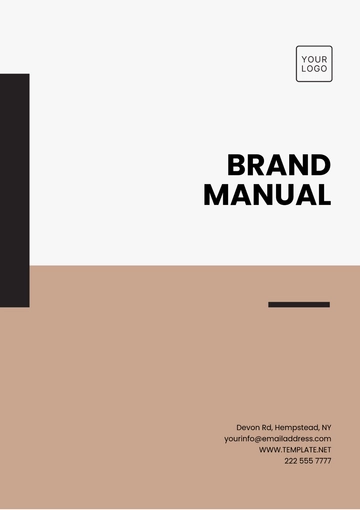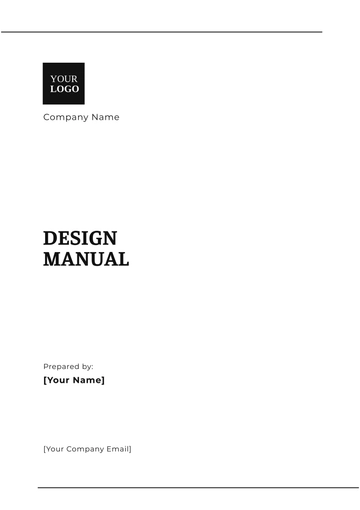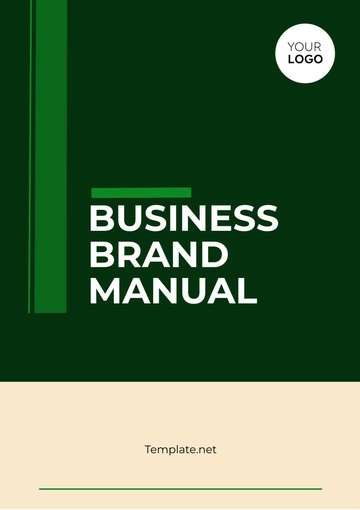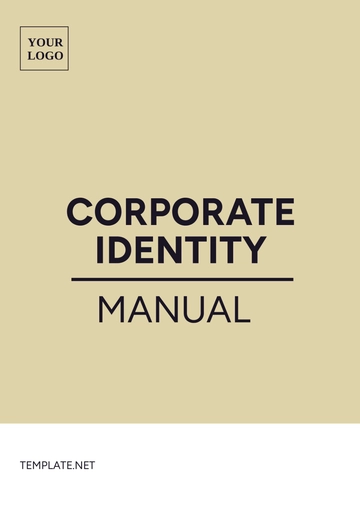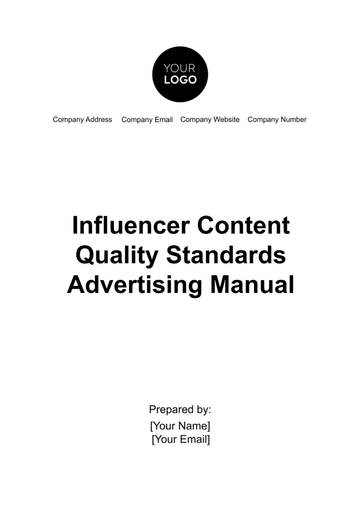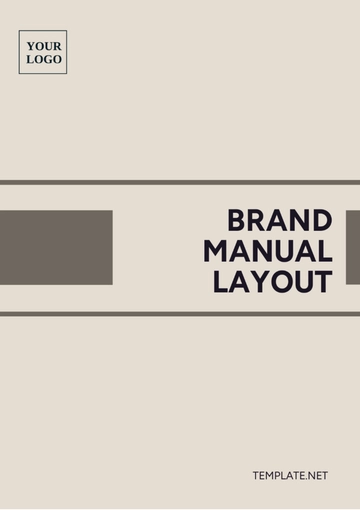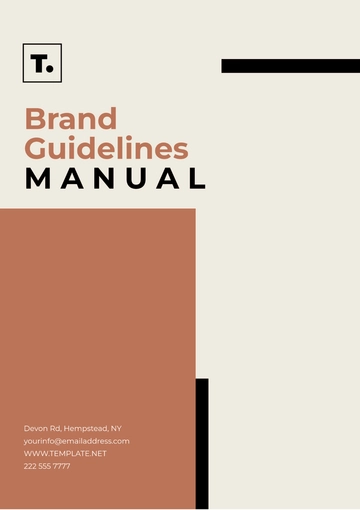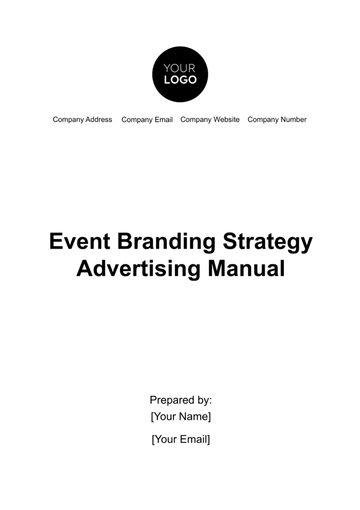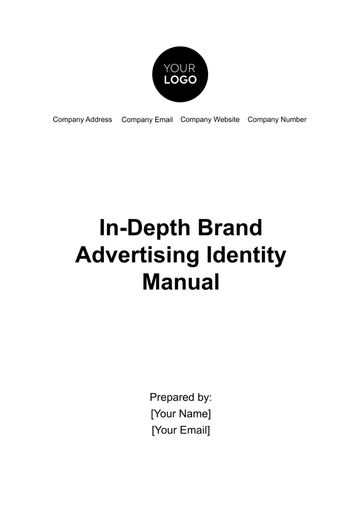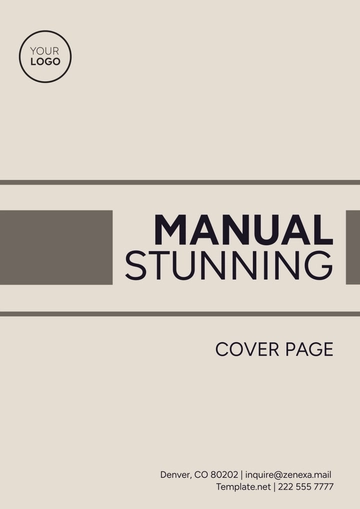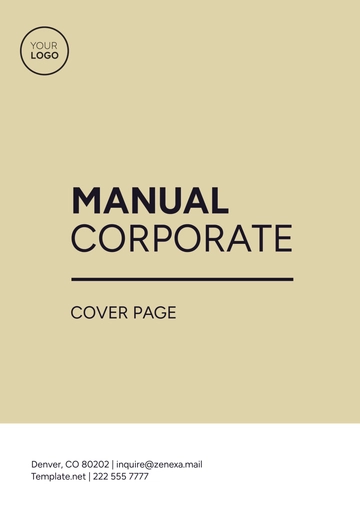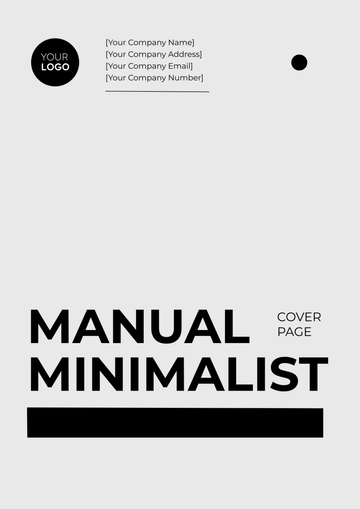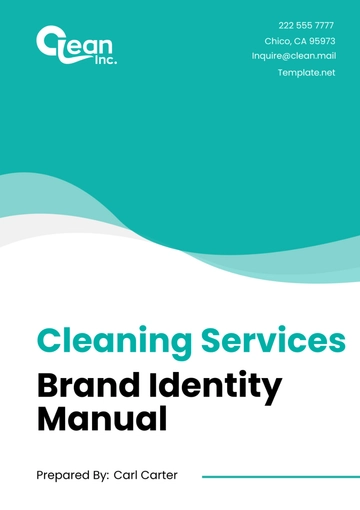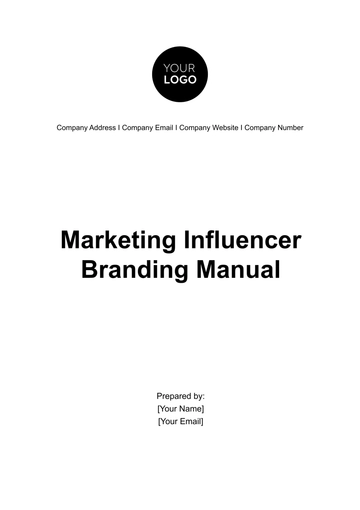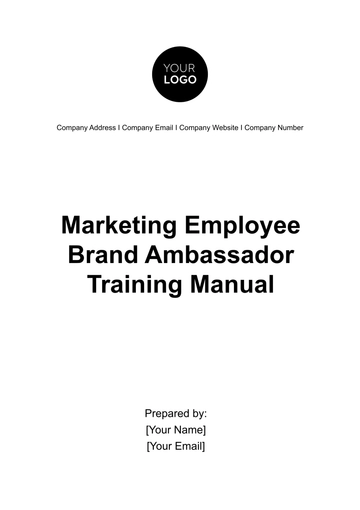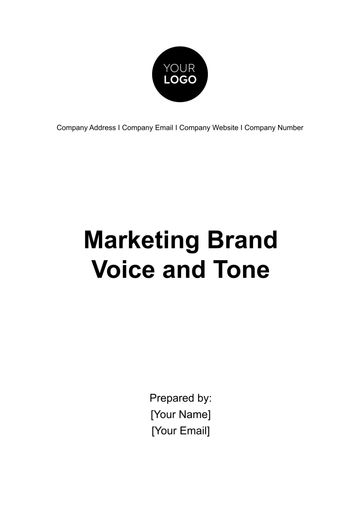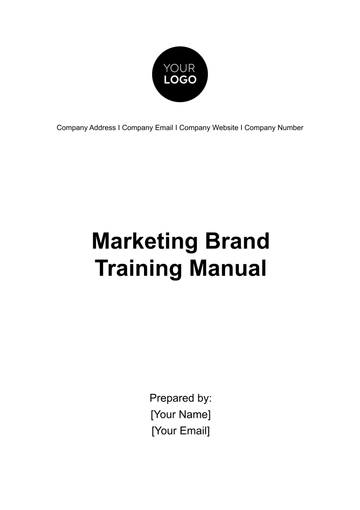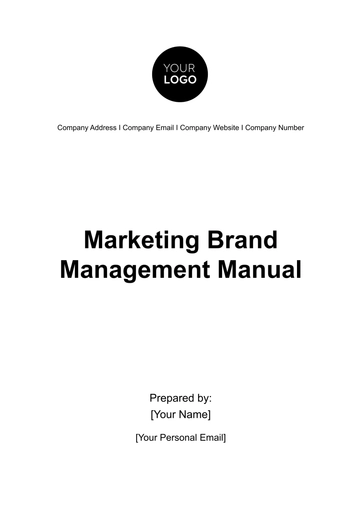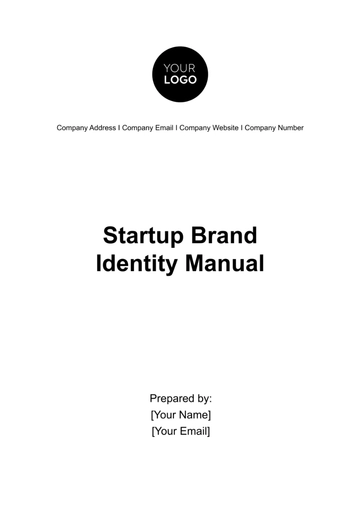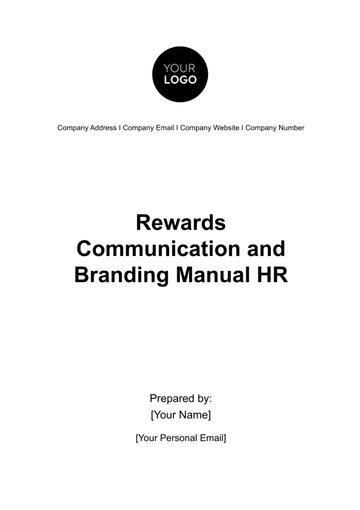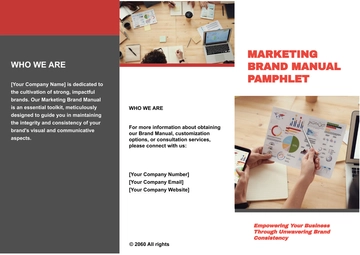Free Administration Corporate Branding Manual

I. Introduction
A. Purpose of the Manual
This Administration Corporate Branding Manual serves as a foundational document outlining the principles, guidelines, and protocols for maintaining the integrity and consistency of the [Your Company Name] brand identity. By providing clear directives on the usage of brand elements and assets, this manual ensures that all communications, both internal and external, reflect a unified brand image. Consistency in branding not only enhances brand recognition but also fosters trust and credibility among stakeholders, contributing to the long-term success and sustainability of [Your Company Name].
B. Scope
The scope of this manual extends to all individuals and entities affiliated with [Your Company Name], including employees, contractors, partners, vendors, and third-party agencies. It applies to all forms of communication and collateral bearing the [Your Company Name] brand, regardless of the medium or platform. From digital platforms such as websites and social media channels to print materials like business cards and brochures, adherence to the guidelines outlined herein is imperative to maintain brand cohesion and uphold the reputation of [Your Company Name] in the marketplace. This manual serves as a comprehensive reference for understanding and implementing the brand identity standards established by [Your Company Name].
II. Brand Overview
A. Brand Mission and Values
At the heart of the [Your Company Name] brand lies a clear and compelling mission: to empower individuals and businesses to achieve their full potential through innovative solutions and unparalleled service. This mission statement encapsulates the overarching purpose and direction of [Your Company Name], guiding our strategic decisions and actions towards creating meaningful impact in the lives of our customers and communities.
In addition to our mission, we are defined by a set of core values that serve as the ethical and cultural compass of our organization. These values, including integrity, collaboration, and continuous improvement, underscore our commitment to excellence, integrity, and customer-centricity. By embodying these values in everything we do, we not only differentiate ourselves in the market but also build enduring relationships with our customers and stakeholders, based on trust, transparency, and mutual respect.
B. Brand Essence
The essence of the [Your Company Name] brand represents the intangible qualities and attributes that make [Your Company Name] unique and memorable in the minds of our audience. Whether it's our unwavering commitment to quality, our passion for innovation, or our dedication to customer satisfaction, our brand essence encapsulates the essence of what sets us apart from competitors. By consistently embodying this essence across all brand touchpoints, we evoke emotional connections and foster brand loyalty among our target audience, driving sustainable growth and success for [Your Company Name].
III. Brand Elements
A. Logo Usage
The [Your Company Name] logo serves as the cornerstone of our brand identity, symbolizing our values, vision, and commitment to excellence. To ensure consistent and effective usage of our logo, adhere to the following guidelines:
Primary Logo: Our primary logo is the preferred version and should be prominently featured in all brand communications to ensure consistency and recognition. It consists of a stylized representation of the following elements:
Iconography: The primary logo features a symbolic icon that represents [Your Company Name]'s core values and essence. This icon may include a key product, a stylized letter, or an abstract symbol.
Typography: The company name is integrated into the logo using a unique and legible font. The typography is carefully chosen to complement the iconography and convey the brand's personality effectively.
Color Scheme: The primary logo is designed using the approved color palette of [Your Company Name]. The colors used in the logo reflect the brand's identity and evoke the desired emotional response from the audience.
Secondary Logo: The secondary logo is a simplified version of our primary logo and is suitable for use in situations where space constraints or design considerations require a more compact format. It maintains the core elements of our brand identity while ensuring legibility and recognition on smaller scales.
B. Color Palette
The [Your Company Name] color palette is carefully curated to evoke specific emotions and associations while maintaining visual consistency across all brand materials. Adherence to our color palette guidelines is essential for reinforcing brand recognition and establishing a cohesive brand identity. Key points to remember include:
Primary Colors: Our primary colors, including [Primary Color 1], [Primary Color 2], and [Primary Color 3], should be used prominently in brand communications to create a strong visual presence and convey our brand personality.
Secondary Colors: Supplementary to our primary palette, our secondary colors, such as [Secondary Color 1], [Secondary Color 2], and [Secondary Color 3], can be used sparingly as accents to add depth and visual interest to our brand materials.
C. Typography
Typography plays a vital role in shaping the perception of our brand and conveying our messaging with clarity and consistency. The following guidelines ensure effective typography usage across all brand communications:
Primary Font: [Primary Font Name] is our primary typeface and should be used for headlines, titles, and other prominent text elements. Its clean, modern aesthetic reinforces our brand's professionalism and innovation.
Secondary Font: [Secondary Font Name] serves as the secondary typeface for body text, paragraphs, and other secondary content. Its readability and versatility make it ideal for conveying information clearly and effectively across various mediums.
IV. Brand Guidelines
A. Visual Identity
Our visual identity encompasses design elements, layout principles, and stylistic considerations that collectively define our brand aesthetic. Adherence to the following guidelines is crucial for maintaining consistency and professionalism in all brand communications:
Layout: Maintain clean, organized layouts that prioritize clarity and ease of navigation. Utilize ample white space to create visual balance and direct attention to key elements.
Spacing and Proportions: Pay attention to spacing between elements to ensure optimal readability and visual hierarchy. Maintain consistent proportions and alignment throughout all brand materials for a cohesive look and feel.
Imagery: Select imagery that aligns with our brand values and messaging. Use high-quality, authentic visuals that resonate with our target audience and reinforce our brand identity.
B. Tone of Voice
The tone of voice of [Your Company Name] reflects our brand personality and values, influencing how we communicate with our audience across various channels. Our tone is characterized by warmth, professionalism, and innovation, which are essential for building meaningful connections with our audience. Whether crafting marketing copy, social media posts, or customer communications, maintaining a consistent tone of voice is key to reinforcing our brand identity and fostering trust and engagement with our audience.
V. Brand Application
A. Stationery
Consistency in stationery design reinforces professionalism and brand recognition. Follow these guidelines for uniformity across stationery items:
Letterheads: Utilize the provided template for official correspondence. Ensure the [Your Company Name] logo is prominently positioned at the top, aligned with contact details. Maintain a clean layout and use the primary color palette for headers and footers.
Envelopes: Use branded envelopes for outgoing mail, featuring the [Your Company Name] logo and return address. Maintain consistency in typography and color scheme to reinforce brand identity.
Business Cards: Design business cards according to the specified format, including [Your Name], [Your Position], [Your Company Name], and contact information. Incorporate the primary logo and adhere to typography guidelines for a cohesive appearance.
B. Digital Assets
A consistent digital presence is crucial for brand cohesion in the digital realm. Follow these guidelines for digital assets:
Website Design: Ensure the website design reflects the brand's visual identity, incorporating the color palette, typography, and imagery consistent with [Your Company Name]. prominently feature the primary logo in the header and footer for brand recognition.
Social Media Graphics: Develop branded templates for social media posts, maintaining consistency in layout, color scheme, and logo placement. Integrate brand messaging and relevant hashtags while adhering to platform guidelines.
Email Templates: Create standardized email templates with branded headers and footers. Utilize the primary color palette and designated typography to maintain consistency across all email communications. Incorporate the [Your Company Name] logo for brand visibility.
VI. Brand Management
A. Approval Process
Establishing a structured approval process ensures brand consistency and quality control. Follow these steps for the approval of brand-related materials:
Submission: Submit all brand-related materials, including designs, copy, and promotional materials, to the designated brand manager or marketing department via [Your Company Email].
Review: The brand manager or marketing team will review the materials to ensure compliance with brand guidelines, consistency, and alignment with brand objectives.
Approval: Once approved, materials will be cleared for distribution or publication. Any necessary revisions will be communicated to the submitter for implementation. Ensure timely feedback to maintain workflow efficiency.
B. Brand Training
Educating employees and stakeholders on brand guidelines and standards is crucial for brand integrity. Conduct comprehensive training sessions covering the following areas:
Brand Identity: Provide an overview of the [Your Company Name] brand, including mission, values, and brand essence. Emphasize the importance of brand consistency and its impact on brand perception.
Brand Guidelines: Review the Administration Corporate Branding Manual in detail, highlighting key guidelines for logo usage, color palette, typography, and tone of voice. Provide practical examples to reinforce understanding.
Practical Applications: Offer hands-on training on applying brand guidelines to various materials, such as presentations, documents, and digital assets. Encourage creativity within established brand parameters.
Q&A Session: Allow participants to ask questions and seek clarification on any aspects of the brand guidelines. Address common misconceptions and provide additional resources for reference.
VII. Brand Maintenance
A. Updates and Revisions
Regular updates and revisions to the Administration Corporate Branding Manual are essential to adapt to changing market dynamics and ensure brand relevance. The following steps outline the process for updates and revisions:
Periodic Review: Conduct periodic reviews of the brand guidelines to identify areas for improvement, emerging trends, and evolving consumer preferences.
Stakeholder Feedback: Solicit feedback from employees, partners, and other stakeholders regarding their experiences and insights on brand implementation. Consider their suggestions for potential updates or revisions.
Alignment with Brand Strategy: Ensure that updates and revisions align with the overarching brand strategy and objectives of [Your Company Name]. Any changes should reflect the evolving needs of the brand and its target audience.
Documentation: Document all updates and revisions to the Administration Corporate Branding Manual, including the rationale behind each change and the date of implementation. Maintain an organized record for future reference and accountability.
B. Compliance
Monitoring Monitoring brand compliance is crucial to maintaining consistency and integrity in brand representation. The following strategies facilitate effective compliance monitoring:
Regular Audits: Conduct regular audits of brand materials and communications to ensure adherence to brand guidelines and standards. Review both internal and external channels, including marketing materials, digital platforms, and customer interactions.
Feedback Mechanisms: Establish channels for stakeholders to report instances of non-compliance or deviations from brand guidelines. Encourage open communication and provide support for addressing any issues identified.
Training and Education: Provide ongoing training and education on brand guidelines and standards to reinforce compliance awareness among employees and partners. Offer resources and support to facilitate understanding and implementation.
Enforcement Measures: Implement enforcement measures for addressing repeated instances of non-compliance or deliberate violations of brand guidelines. Clearly communicate consequences for disregarding brand standards to deter future infractions.
VIII. Contact Information
For inquiries or assistance related to [Your Company Name]'s brand guidelines, please contact:
[Your Name]
[Your Position]
[Your Company Email]
[Your Company Number]
- 100% Customizable, free editor
- Access 1 Million+ Templates, photo’s & graphics
- Download or share as a template
- Click and replace photos, graphics, text, backgrounds
- Resize, crop, AI write & more
- Access advanced editor
Craft a cohesive brand identity with the Administration Corporate Branding Manual Template from Template.net. This editable and customizable document serves as a comprehensive guide to maintaining brand consistency across all corporate communications. Define logo usage, typography, color palette, and brand voice to ensure a unified brand image. Editable in our Ai Editor Tool for effortless customization to align with your brand guidelines.
